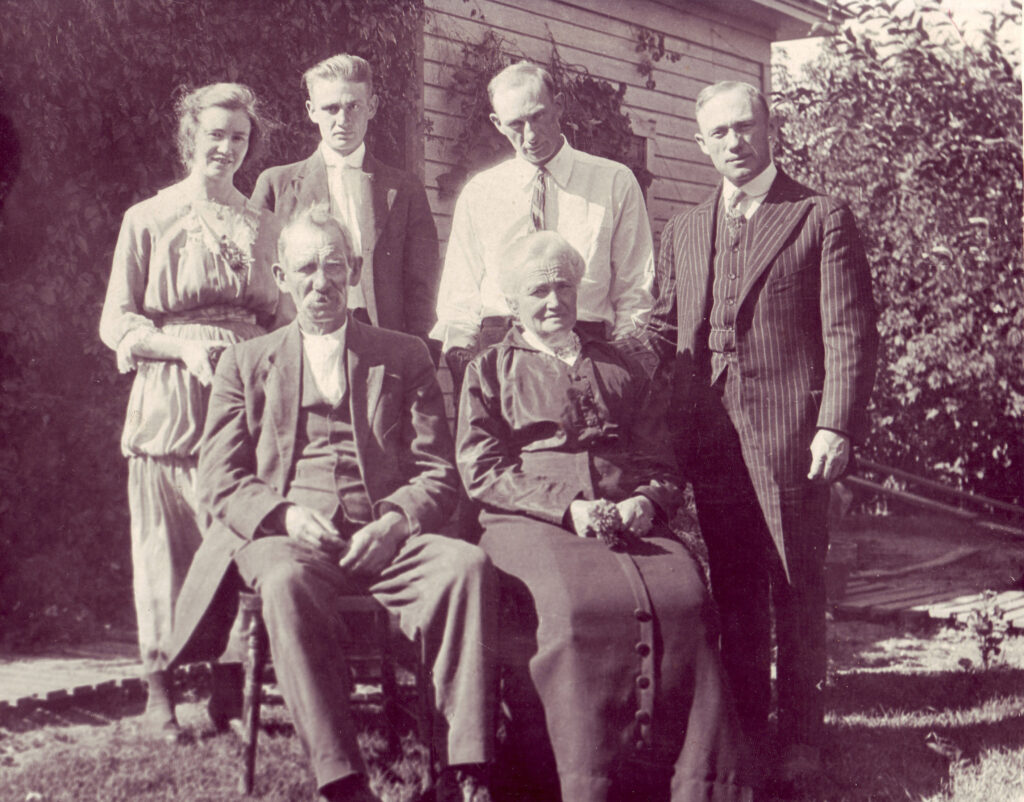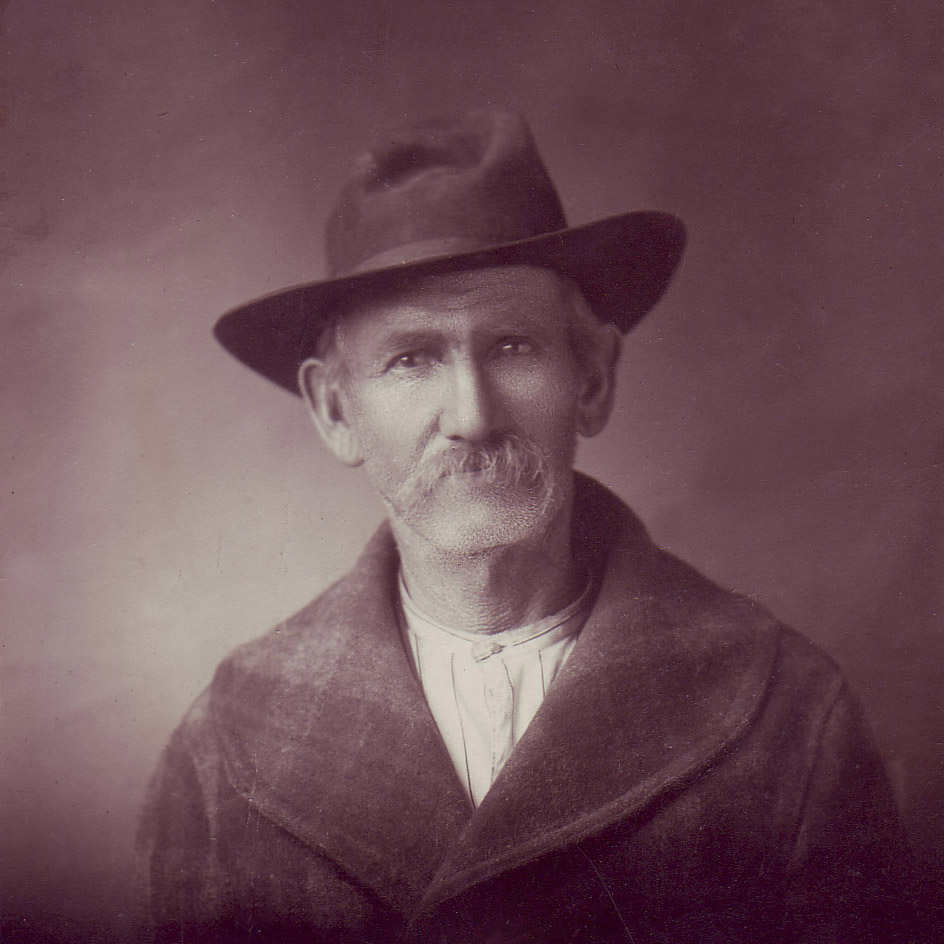My great grandfather, Benjamin Franklin “Frank” Milner is buried beside his wife Ella in the Temple Hill Cemetery1 near Raymond, Ab. I remember we’d always take the time to check out his gravestone whenever we visited there but even my dad is too young to have known Frank, since my dad was born 18 years after he died. It’s not surprising though because my Great Grandpa Milner was really old. For some perspective, he was born seven years before the start of the American Civil War and another full 40 years before Utah achieved statehood.
I don’t know too much about Frank except what I’ve read in the excerpt below from p.196-198 of Valiant in the Faith, with spelling corrections, notes, and links added by me.
BENJAMIN FRANKLIN MILNER was born 19 September 1855 in Provo, Utah of pioneer parents, converts from England who came to Utah in 1852. His father, John Brewitt Milner and Grandmother, Ann Brewitt Johnson Milner, came from Nottinghamshire in 1853. They came across the plains in the same company as a young widow from Birmingham, Esther Elizabeth Yardley Thurman, and her young son, Thomas. John B. Milner and Esther were married in 1854 in Salt Lake City. When a small boy, Frank went to live with his grandmother Milner2. He was well taken care of, given strict but kind training, and was much adored by his grandmother. She later married Thomas Needham, but Frank lived with her until her death in 1882.
On June 9, 1886, Frank married Sarah Ellen [“Ella”] Kinsman in the Logan Temple, traveling to and from Logan in a wagon, and accompanied by her mother, [Sarah Jane Snow] and aunt. They lived the first year on Judge John B. Milner’s farm, on the State road mid way between Provo and Springville.
Many times they sheltered some of the Church officials who were living in polygamy and who stayed over night and left early in the morning for Manti and St. George. After they were on their way, Frank and Ella destroyed the wagon wheel marks going in or out of the place. One day, the sheriff, Charley Redfield, and his deputies called at their home, but only Ella was at home. He had heard that Milners had an underground on the farm, and they had come to inspect it. She told him, yes, they had one, and getting her sunbonnet she would show it to them, and led the way down into the field. She pointed to a little path that led into a hole in the side of a bank large enough for a man to enter, but it was dark so one couldn’t see in. The sheriff asked if a person entered, could he come out again? Ella said she didn’t think so because the neighbors had an old sow and seven piglets that went down into it and never were seen again. The sheriff burst out laughing and left and never came again. He was after polygamists. Many times Ella and Frank helped some polygamists to escape when the deputies were hot on their trail. When Joseph H. Smith’s mother, Josephine [Groesbeck] was staying at Provo, deputies came, and she and her baby left through the window. Frank had taken Ella to her mother’s so he had his trotter and buggy handy. Taking Ella’s coat and hat he put them on Sister Smith in the buggy, and drove her right past the deputies who thought it was Ella with him. He took her to another home on the Bench3 where she was safe for awhile.
Frank loved horses and to ride and drive the frisky or spirited ones. One little mare, a Spanish Mustang, was very spirited and threw him off and broke his right arm at the elbow, which not being set correctly remained stiff in the joint. He had a fast trotter horse which he named Royal George, and often Frank hitched him to the buggy and proudly trotted him down Main Street. He owned a white Hamiltonian race horse named Missouri, and kept old Missouri until he died of old age. He was gentle and the children could climb all over him and ride him or drive him in a buggy. Another horse was a grey mare named Grace, a very lively and high spirited horse. The children could drive her in the buggy and also ride her. Every time a saddle was put on her she would turn her head and give a good nip on the shoulder or arm. Whenever she heard the band play she would step to the music and dance along while the teammate would plod along as usual.
In 1886 Frank’s work of driving artesian flowing wells took him to Ogden where he dug a well for the Union Pacific. He also drove one at the old Social Hall in Provo First Ward, 2nd East and 2nd South, and others around Provo. He freighted for the Charleston creamery through Provo Canyon. Some of the trips up through Provo Canyon were dangerous because of the snowslides. Once he was coming down and stopped for a short rest for the horses and was warned not to go on because there was danger of a slide, but he determined to go on anyway. Just after he left, a slide came down behind him, and then some distance on one came down ahead of him so he was caught between the two and had to stay there until a passage could be broken through. Frank became interested in mining about 1898 with a Mr. Besltemeyer [sic].
B. F. Milner raised sugar beets in partnership with Charles Turner, who had married Ella’s cousin, Lida. They were very successful with the beets and raised very good acreage on a field East on Center Street. Jesse Knight was a neighbor, and his nephew, Jesse J. Knight, had married Frank’s sister, Lilly. Jesse Knight became quite wealthy from a mining project and invested heavily in the sugar factory and land in me new town at Raymond, Alberta, Canada about 1901-1902. Jesse persuaded Turner and Milner to take positions as field superintendents—Turner to go to Greeley, Colorado, and Milner to Raymond. Frank left Provo with Will and Emily Bullock and their family, with the promise of being superintendant of the factory’s beet fields. When Frank arrived in Raymond Jan. 29, 1903 he was told that the position was already filled by a relative of Mr. Ellison, but offered Milner team work and the opportunity of raising beets on his own land for the factory. Frank bought about 95 acres of land, 80 acres north of the town, 10 acres north and west, and 5 acres five blocks west of town where he built his home. He said later it was a good thing he didn’t get the job because he was able to do better for himself in other ways. He could turn his hand to many things and had good equipment for farm work. He did carpentry work until he could work the ground for planting his sugar beets, potatoes, grain and a small garden. Frank said that the beet seed bought from Germany was third class seed, and to prove it he grew his own seed and raised beets that tested higher in saccharin, weighing 15-16 lbs., too large to run through the slicer. So he had to top, wash and cut his beets to a size that could be sliced at the factory.
Five years later he became superintendent of the John A. Silver dry farm of 2300 acres about six miles southeast of Lethbridge. Later, Silver sold his farm and bought the Lethbridge Iron Works in a partnership with Mr. Magrath, and after some years Silver sold out and moved back to Utah because of ill health.
Frank had a way with horses. He traded a horse for one that had a mean disposition, called Outlaw, that his friend owned and had a hard time to bridle. The friend tied the horse close to a post or wagon, then would climb up on something to try to pry his moudi open with an iron bar so he could put on his bridle. Father made a bet with the friend that inside of a week he would be able to go out and catch him and put his bridle on without any trouble. Later on he demonstrated this by going out and walking right up to the horse and picked up his left front foot and buckled a strap around his leg above and below the knee, holding it in a bent position off the ground. Then while the horse was thinking about that, he would pet his head and slip on the bridle just as easy as that. It wasn’t long until we could catch him and bridle him without strapping up his knee.
Frank was always mindful of the widows who needed help. Whenever he killed a beef or pork he would send a piece to the widows in the area. He rented an 80-acre farm that had remained unplanted for several years as the owner was a widow with no help to farm it. He seeded this land to flax and raised a very fine crop on it during World War I which brought a very tidy sum of money. When he settled up with her and gave her the part they had agreed on, she was very happy although she had had to wait all winter before the flax could be threshed and sold. She said that Frank Milner was the most honest man she had ever known because he kept an account of what he promised to do and dealt accordingly.
When he came to Salt Lake in the winters of 1923-1925 to visit [his daughter] Ella, he did Temple work in the Salt Lake Temple for a number of his English ancestors. His death occurred 16 November 1926.
—Written by his daughter, Ella M. Bennett

Front: Frank, Ella; Back: Ella, Earl, Newell, Fayne
Brother and Sister Milner… were pioneers. When they went to Canada in 1903 there were about five families—among the first to build a house. They erected a four room house on the five acre plot west of Raymond. While they were building this house they lived in a tent on the south side of the house; when they moved in they had the kitchen partly finished. They are people who went out and plowed the first furrow on certain pieces of land, who learned to cultivate the prairies where you plowed a furrow a quarter of a mile long and there wouldn’t be a break in the ground, the sod was thick and heavy. They had pluck and courage and lots of it.
-Tribute by W. Clark Scott.
- My grandpa Marshall used to jokingly call it Boot Hill. Boot Hill is the name or nickname of many cemeteries in the old west with reputations for the number of men that died with their boots on (presumably involving gun play or hangings). The Raymond cemetary was called Temple Hill because of the hope and plans by the folks in Raymond to have the first latter-day saint temple built there—ultimately the Alberta Temple got built in Cardston much to the multigenerational disappointment of the locals in Raymond. I guess a cemetery is the next best thing?[↩]
- I assume this was after his parents John and Elizabeth separated/divorced.[↩]
- I believe “the Bench” is referring to The East Bench in Provo and Salt Lake City.[↩]

The “bench” referred to in the paragraph above is right across the street east of the Provo Cemetary. It is actually the same bench as is located in Salt Lake. The bench is nothing but the foothills of the Wasatch mountains.